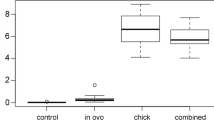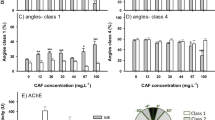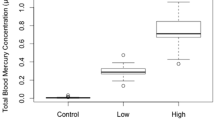Abstract
We developed a standardized protocol for comparing the sensitivities of the embryos of different bird species to methylmercury when methylmercury was injected into their eggs. During the course of developing this protocol, we investigated the effects of various factors on the toxicity of the injected methylmercury. Most of our experiments were done with chicken (Gallus domesticus), mallard (Anas platyrhynchos), and ring-necked pheasant (Phasianus colchicus) eggs, all of which were purchased in large numbers from game farms. A smaller amount of work was done with double-crested cormorant (Phalacrocorax auritus) eggs collected from the wild. Several solvents were tested, and corn oil at a rate of 1 μl/g egg contents was selected for the final standardized protocol because it had minimal toxicity to embryos and because methylmercury dissolved in corn oil yielded a dose–response curve in a range of egg concentrations that was similar to the range that causes reproductive impairment when the mother deposits methylmercury into her own eggs. The embryonic stage at which eggs were injected with corn oil altered mercury toxicity; at early stages, the corn oil itself was toxic. Therefore, in the final protocol we standardized the time of injection to occur when each species reached the morphologic equivalent of a 3-day-old chicken embryo. Although solvents can be injected directly into the albumen of an egg, high embryo mortality can occur in the solvent controls because of the formation of air bubbles in the albumen. Our final protocol used corn oil injections into the air cell, which are easier and safer than albumen injections. Most of the methylmercury, when dissolved in corn oil, injected into the air cell passes through the inner shell membrane and into the egg albumen. Most commercial incubators incubate eggs in trays with the air cell end of the egg pointing upward, but we discovered that mercury-induced mortality was too great when eggs were held in this orientation. In addition, some species of bird eggs require incubation on their sides with the eggs being rolled 180° for them to develop normally. Therefore, we adopted a procedure of incubating the eggs of all species on their sides and rolling them 180° every hour. Little has been published about the conditions of temperature, humidity, and the movements to which eggs of wild birds need to be subjected for them to hatch optimally under artificial incubation. Not unexpectedly, hatching success in an artificial incubator is generally less than what natural incubation by the parents can achieve. However, the survival of control embryos of most wild bird species was good (generally ≥ 80%) up to within 1 or 2 days of hatching when we incubated the eggs at 37.5°C (or 37.6°C for gallinaceous species) at a relative humidity that resulted in an approximate 15% to 16% loss in egg weight by the end of incubation and by incubating the eggs on their sides and rolling them 180°/h. To improve statistical comparisons, we used survival through 90% of incubation as our measurement to compare survival of controls with survival of eggs injected with graded concentrations of mercury.













Similar content being viewed by others
References
Birge WJ, Roberts OW (1976) Toxicity of metals to chick embryos. Bull Environ Contam Toxicol 16:19–324
Borg K, Wanntorp H, Erne K, Hanko E (1969) Alkyl mercury poisoning in terrestrial Swedish wildlife. Viltrevy 6:301–379
Brunström B, Örberg J (1982) A method for studying embryotoxicity of lipophilic substances experimentally introduced into hens’ eggs. Ambio 11:209–211
Deeming DC (2002) Avian incubation. Oxford University Press, Oxford, UK, p. 31
Eisler R (2000) Handbook of chemical risk assessment: Health hazards to humans, plants, and animals. Volume 1. Metals. Lewis, Boca Raton, FL
Fimreite N (1971) Effects of dietary methylmercury on ring-necked pheasants. Canadian Wildlife Service Occasional Paper 9, Canadian Wildlife Service, Ottawa
Gilman AP, Hallett DJ, Fox GA, Allan LJ, Learning WJ, Peakall DB (1978) Effects of injected organochlorines on naturally incubated herring gull eggs. J Wildl Manage 42:484–493
Harvey R (1993) Practical incubation. Hancock House, Blaine, WA
Heinz GH (1979) Methylmercury: Reproductive and behavioral effects on three generations of mallard ducks. J Wildl Manage 43:94–401
Henny CJ, Hill EF, Hoffman DJ, Spalding MG, Grove RA (2002) Nineteenth century mercury: Hazard to wading birds and cormorants of the Carson River, Nevada. Ecotoxicology 11:213– 231
Hoffman DJ, Moore JM (1979) Teratogenic effects of external egg applications of methyl mercury in the mallard, Anas platyrhynchos. Teratology 20:453–462
Landauer W (1967) The hatchability of chicken eggs as influenced by environment and heredity. Monograph 1. University of Connecticut Agricultural Experiment Station, Storrs, CT
Magos L, Brown AW, Sparrow S, Bailey E, Snowden RT, Skipp WR (1985) The comparative toxicology of ethyl- and methyl-mercury. Arch Toxicol 57:260–267
Meyer MW, Evers DC, Hartigan JJ, Rasmussen PS (1998) Patterns of common loon (Gavia immer) mercury exposure, reproduction, and survival in Wisconsin, USA. Environ Toxicol Chem 4:184–190
Nishimura M, Urakawa N (1976) A transport mechanism of methyl mercury to egg albumen in laying Japanese quail. Jap J Vet Sci 38:433–444
Powell DC, Aulerich RJ, Meadows JC, Tillett DE, Kelly ME, Stromborg KL, et al. (1998) Effects of 3,3(,4,4(,5-pentachlorobiphenyl and 2,3,7,8-tetrachlorodibenzo-p-dioxin injected into the yolks of double-crested cormorant (Phalacrocorax auritus) eggs prior to incubation. Environ Toxicol Chem 17:2035-2040
Rumbold DG, Niemczyk SL, Fink LE, Chandraesekhar T, Harkanson B, Laine KA (2001) Mercury in eggs and feathers of great egrets (Ardea albus) from the Florida Everglades. Arch Environ Contam Toxicol 41:501–507
Sanderson JT, Bellward GD (1995) Hepatic microsomal ethoxyresorufin 0-deethylase-inducing potency in ovo and cystolic Ah receptor binding affinity of 2,3,7,8-tetrachlorodibenzo-p-dioxin: comparison of four avian species. Toxicol Appl Pharmacol 132:131–145
Scheuhammer AM (1987) The chronic toxicity of aluminum, cadmium, mercury, and lead in birds: A review. Environ Pollut 46:263–295
Scheuhammer AM, Perrault JA, Bond DE (2001) Mercury, methylmercury, and selenium concentrations in eggs of common loons (Gavia immer) from Canada. Environ Monit Assess 72:79–94
Sell JL, Guenter W, Sifri M (1974) Distribution of mercury among components of eggs following administration of methylmercuric chloride to chickens. Agric Food Chem 22:248–251
Simpson PG, TE Hopkins, Haque R (1973) Binding of methylmercury chloride to the model peptide, N-Acetyl-L-cysteine. A proton magnetic study. J Phys Chem 77:2282–2285
Spann JW, Heath RG, Kreitzer JF, Locke LN (1972) Ethyl mercury p-toluene sulfonanilide: Lethal and reproductive effects on pheasants. Science 175:328–331
Tejning S (1967) Biological effects of methyl mercury dicyandiamide-treated grain in the domestic fowl Gallus gallus L. Oikos suppl 8:1–116
Thompson DR (1996) Mercury in birds and terrestrial mammals. In: Beyer WN, Heinz GH, Redmond-Norwood AW (eds) Environmental contaminants in wildlife: interpreting tissue concentrations. Lewis, Boca Raton, FL, pp 341–356
Walker NE (1967) Distribution of chemicals injected into fertile eggs and its effect upon apparent toxicity. Toxicol Appl Pharmacol 10:290–299
Wiemeyer SN, Lamont TG, Bunck CM, Sindelar CR, Gramlich FJ, Frazer JD, et al. (1984) Organochlorine pesticide, polychlorobiphenyl, and mercury residues in bald eagle eggs—1969-79—and their relationships to shell thinning and reproduction. Arch Environ Contam Toxicol 13:529–549
Wiener JG, Krabbenhoft DP, Heinz GH, Scheuhammer AM (2003) Ecotoxicology of mercury. In: Hoffman DJ, Rattner BA, Burton Jr GA, Cairns Jr J (eds) Handbook of ecotoxicology. Lewis, Boca Raton, FL, pp 409–463
Wolfe MF, Schwarzbach S, Sulaiman RA (1998) Effects of mercury on wildlife: A comprehensive review. Environ Toxicol Chem 17:146–160
Acknowledgments
We thank Dan Murray, Michael Hoffman, and Michael Hammond for their help in conducting the laboratory parts of the study and Paul Spitzer for help in collecting eggs in the field.
Author information
Authors and Affiliations
Corresponding author
Rights and permissions
About this article
Cite this article
Heinz, G.H., Hoffman, D.J., Kondrad, S.L. et al. Factors Affecting the Toxicity of Methylmercury Injected into Eggs. Arch Environ Contam Toxicol 50, 264–279 (2006). https://doi.org/10.1007/s00244-005-1002-y
Received:
Accepted:
Published:
Issue Date:
DOI: https://doi.org/10.1007/s00244-005-1002-y




